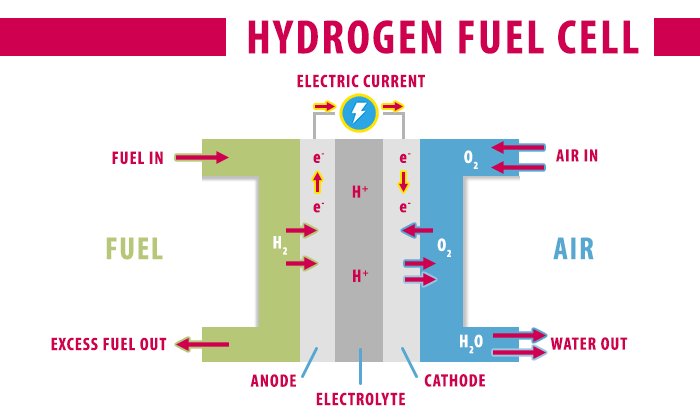Table of Contents
Indigenous Hydrogen Fuel Cell ferry
Context: PM Narendra Modi commenced the operation of the nation’s first indigenously built hydrogen fuel ferry boat.
More in News
- Cochin Shipyard was responsible for the construction of the hydrogen fuel cell ferry.
- The inauguration of the ferry coincides with a significant ₹17,300-crore project in Thoothukudi, Tamil Nadu, aimed at laying the foundation stone for a key energy project.
About Hydrogen Fuel Cell
A hydrogen fuel cell is an electrochemical device that converts the chemical energy of hydrogen and an oxidising agent (usually oxygen) into electricity through a pair of redox reactions.

- Definition:
- A hydrogen fuel cell generates electricity by utilising the chemical reaction between hydrogen and oxygen.
- It operates with high efficiency and produces only water as a by-product.
- Working Principle:
- A typical hydrogen fuel cell consists of:
- Anode: Hydrogen enters the fuel cell via the anode.
- Cathode: Oxygen from the ambient air enters through the cathode.
- Electrolyte Membrane: Separates the anode and cathode.
- The process:
- Hydrogen atoms at the anode react with a catalyst, splitting into electrons and protons.
- Protons pass through the electrolyte membrane to the cathode.
- Electrons flow out of the cell, generating an electric current.
- At the cathode, protons and oxygen combine to produce water.
- A typical hydrogen fuel cell consists of:
- Significance:
- Clean Energy: Hydrogen fuel cells are zero-emission when burned with oxygen.
- Efficiency: They can produce more energy than diesel or petrol.
- Applications:
- Emergency backup power for critical facilities (e.g., hospitals).
- Replacing grid electricity for data centres.
- Powering transportation modes (cars, buses, trains, forklifts).
- Potential use in low-carbon cities, portable devices, and future zero-emission aircraft.
We’re now on WhatsApp. Click to Join
Rare Diseases
Context: Resource constraints apart, India languishes near the bottom on awareness, diagnosis, and drug development for rare diseases.
Magnitude of the Rare Diseases in India
- India accounts for 1/3 of global rare disease cases, with over 450 identified diseases affecting 8-10 crore people, 75% of whom are children.
- Despite the high prevalence, these diseases are largely overlooked due to lack of awareness, diagnosis, and treatment options.
Challenges
Diagnosis And Treatment
- It takes an average of 7 years to diagnose rare diseases due to lack of physician training and awareness.
- Less than 50% of identified diseases have treatments available, and only 20 have drugs approved in India.
- These drugs are often exorbitantly priced and only accessible through the limited network of 12 unevenly distributed Centres of Excellence (CoEs).
Inadequate government support
- The national policy (National Policy for Rare Diseases) lacks a clear definition of “rare diseases” and faces implementation challenges.
- Budgetary allocation for rare diseases remains low at ₹93 crore, with limited utilisation due to concerns of CoEs regarding cost overruns and potential legal action.
- The NPRD encourages CoEs to crowdfund, highlighting the lack of sustainable solutions.
Recommendations for improvement
- Central government:
- Define “rare diseases” and develop a comprehensive national policy.
- Increase budgetary allocation and dedicate funding for drug development and therapy.
- Expand the network of CoEs and ensure their proper coordination and resource utilisation.
- State governments:
- Introduce social assistance programs and develop satellite centres under CoEs.
- Public and private sectors:
- Collaborate through Corporate Social Responsibility (CSR) initiatives and partnerships to address funding shortfalls.
- Addressing drug prices and availability:
- Withdraw GST on life-saving drugs for rare diseases.
- Incentivize domestic drug production through schemes like PLI.
- Reduce clinical trial requirements for rare diseases.
- Explore options like repurposed drugs and bulk imports
UAPA
Context: The Union Home Ministry declared two factions of the Muslim Conference, Jammu and Kashmir (MCJK), led by Abdul Ghani Bhat and Ghulam Nabi Sumji, respectively, as “unlawful association” under the anti-terror Unlawful Activities (Prevention) Act (UAPA).
About Unlawful Activities (Prevention) Act (UAPA)
- Definition: The Unlawful Activities (Prevention) Act, 1967, is an Indian law aimed at identifying, prohibiting, and legally addressing individuals, organisations, and activities involved in unlawful or terrorist actions that endanger India’s sovereignty, territorial integrity, and security.
- Key Provisions: The Unlawful Activities (Prevention) Act, 1967 (UAPA) empowers the Central Government to declare an individual (2019 Amendment) or an organisation as a terrorist/terrorist organisation if they have
- Committed, participated in, prepared for, promoted, or are otherwise involved in terrorism.
- To impose all-India bans on associations that are declared “unlawful”.
- Indian nationals and foreign nationals can be charged under the Act, and
- Offenders can be held accountable in the same manner even if the crime was committed on foreign land outside India.
- Genesis:
- 1963: The Committee on National Integration and Regionalism, appointed by the National Integration Council, makes recommendations.
- The Constitution (Sixteenth Amendment) Act is enacted, empowering Parliament to restrict certain fundamental rights (speech, assembly, association) for national security.
- 1967: The UAPA is passed by Parliament to:
- Implement the restrictions outlined in the 16th Amendment.
- Safeguard India’s sovereignty and integrity.
- 1963: The Committee on National Integration and Regionalism, appointed by the National Integration Council, makes recommendations.
Applicability:
- The law is applicable to both Indian and foreign nationals, and it extends to the whole of India.
- Also includes:
(a) citizens of India outside India;
(b) persons in the service of the Government, wherever they may be; and
(c) persons on ships and aircrafts, registered in India, wherever they may be.
| Amendments to the Unlawful Activities (Prevention) Act (UAPA) |
2004 Amendment:
2019 Amendment:
|
AI : Concerns
Context: Advancements in AI necessitate global governance to mitigate risks.
What Are the Concerns Related to AI?
- Digital Sovereignty: AI creates new digital spaces governed by those who control the AI systems, potentially impacting a nation’s control over its digital domain.
- Countries lacking AI development and regulations may become reliant on more advanced nations, impacting their sovereignty across various sectors.
- Democracy: AI can be misused by foreign powers to manipulate information and influence public opinion, impacting democratic processes.
- This can be done through spreading misinformation and disinformation, affecting public sentiment and potentially leading to conflict.
- Lethal Autonomous Weapons Systems (LAWS): These raise ethical and technical concerns due to:
- Unintended escalation: They might operate based on pre-programmed criteria, lacking human judgment and potentially leading to civilian casualties.
- Hacking/malfunctioning: This could result in unintended attacks and endanger lives.
- Ethical concerns: The absence of human oversight in life-and-death decisions is problematic.
- The proliferation of LAWS could lead to an arms race, destabilisation, and potential use by non-state actors.
- Cybersecurity: AI can be used for sophisticated cyberattacks that threaten critical national infrastructure, impacting a nation’s stability and security.
- These attacks can originate from anywhere, making it challenging to safeguard national interests in the interconnected digital world.
- Global Stability: The uncontrolled proliferation and potential arms race in autonomous weapons technology threaten global stability and diplomatic balance.
- Humanitarian Law: The use of LAWS challenges the principles of humanitarian law, particularly the moral and ethical implications of life and death decisions made without human oversight.
- Autonomy and Control: The borderless and highly adaptable nature of AI technology makes it difficult to regulate, increasing the risk of its misuse by various non-state actors and authoritarian regimes.


 Cabinet Committee on Security Suspends I...
Cabinet Committee on Security Suspends I...
 Pahalgam Terror Attack: All Eyes on Paha...
Pahalgam Terror Attack: All Eyes on Paha...
 World Immunization Week (24 to 30 April)...
World Immunization Week (24 to 30 April)...






















